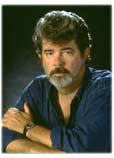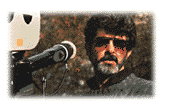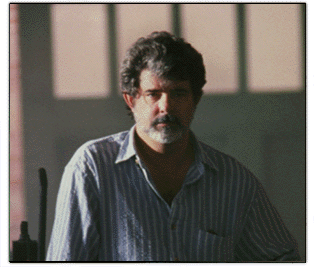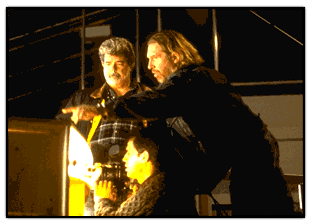Crew
Profiles: George Lucas..
 The first time I met
George Lucas
I couldn't help thinking..... is this really the Director? I guess I
was looking for someone with a commanding presence like
Alfred
Hitchcock or
John
Huston..... that certainly didn't
describe the man that was heading the moderately budgeted ($11m)
project on which I found myself. George was really rather quiet and
unassuming. He looked like a recent post graduate, was rather
introverted, more the personality of an Editor than a Director. I
remember him sporting a baseball cap.... which were not that common
in Britain in those days. It looked rather odd in an indoor studio
set.
The first time I met
George Lucas
I couldn't help thinking..... is this really the Director? I guess I
was looking for someone with a commanding presence like
Alfred
Hitchcock or
John
Huston..... that certainly didn't
describe the man that was heading the moderately budgeted ($11m)
project on which I found myself. George was really rather quiet and
unassuming. He looked like a recent post graduate, was rather
introverted, more the personality of an Editor than a Director. I
remember him sporting a baseball cap.... which were not that common
in Britain in those days. It looked rather odd in an indoor studio
set.
I hadn't seen
AMERICAN
GRAFFITI, I don't think many
of us had, but the word on the set was that this guy
George Lucas,
that we had never heard of, was
really "up and coming". To be honest we had heard that about a lot of
other people who had long since disappeared and I think most of us
were much more impressed to be working with
Alec
Guiness who had been a
legendary star for decades.
 George was affectionately referred to as "the guv'ner" a
term often used by British movie crews to refer to the Director but
he handled himself in so gentile a fashion that it was hard to
imagine him as the driving force behind anything. I don't want to
suggest he was indecisive... he seemed to know what he wanted.... he
was just very quiet about asking for it.
George was affectionately referred to as "the guv'ner" a
term often used by British movie crews to refer to the Director but
he handled himself in so gentile a fashion that it was hard to
imagine him as the driving force behind anything. I don't want to
suggest he was indecisive... he seemed to know what he wanted.... he
was just very quiet about asking for it.
To put everything in context you have
to remember that the huge explosion of cheap Science fiction films of
the 50's seemed to have pretty well exhausted the subject and was
followed by comparatively few in the 60's. As we prepared for George
Lucas's third feature we were less than a decade after movies like
"Godzilla vs. the Smog
Monster" (1971) and
"They Came From Beyond
Space" (1967). We were all a
little insecure about finding ourselves making another Sci-Fi flick,
though we were happy just to be working. As preproduction progressed
we had little indication that the movie we were making, which used
weird terms like "parsecs" and "hyper drive" and seemed rather
inanely titled
STAR
WARS, was literally about to
jump into movie hyper space. The first signs of the project's scale
and originality were as the sets approached completion. Quite
suddenly a unique vision emerged.
At the end of the movie several
technicians, including myself, were presented with a book of stills
from the movie... an
unpresidented gift from
Lucasfilm. It
demonstrated George's concern and appreciation for his crew (which is
far from common in this cut-throat industry. I was deeply touched by
the inscription in the back which reads "Nick
Maley - Thank you for your contribution to Star
Wars" and is signed
"George
Lucas" and
"Gary Kurtz".



By the time we got to
THE
EMPIRE STRIKES BACK, (3 years
later) the unassuming genius that lead us was transformed into a
legend but it seemed as if it weighed heavily upon him. He now seemed
not so much quiet as pensive.....was much more serious than before...
like ten years older, and far more forceful.
One of the biggest surprises for me
was when he was reported to have said that the best thing about
STAR
WARS was that he would never
have to direct a movie again! Well 22 years later he appears to have
reconsidered because
STAR
WARS Episode 1 will soon
become his fourth film as Director.
 Nick.
Nick.
Writer, Director and Executive
Producer
THE OFFICIAL LUCASFILM
BIO
 George
Lucas is the creator of the phenomenally
successful
STAR
WARS saga and the Indiana Jones series, and
is Chairman of the Board of Lucasfilm Ltd., LucasArts Entertainment
Company, and Lucas Digital Ltd.
George
Lucas is the creator of the phenomenally
successful
STAR
WARS saga and the Indiana Jones series, and
is Chairman of the Board of Lucasfilm Ltd., LucasArts Entertainment
Company, and Lucas Digital Ltd.
Lucas directed his first feature film, THX 1138, in
1970. The film was produced by American Zoetrope and
executive-produced by Francis Coppola. In 1971, Lucas formed his own
film company,Lucasfilm Ltd., in San Rafael, California.
In 1973, Lucas co-wrote and directed
AMERICAN GRAFFITI. The
film won the Golden Globe, the New York Film Critics' and National
Society of Film Critics' awards, and garnered five Academy Award
nominations.
Four years later, Lucas wrote and directed
STAR
WARS
(actually that's when it was
released) -- a film which broke all box office
records and earned seven Academy Awards. Lucas went on to write the
stories for
THE
EMPIRE STRIKES BACK and
RETURN OF THE JEDI,
which he also executive-produced. In 1980, he was executive producer
of RAIDERS OF THE LOST
ARK, directed by
Steven Spielberg,
which won five Academy Awards. He was also the co-executive producer
and creator of the story for INDIANA JONES AND
THE TEMPLE OF DOOM. The film, released in
1984, earned two Acadmey Award nominations and won an Oscar for its
visual effects.
In 1986, Lucas served as executive producer for
Disneyland's 3D musical space adventure
Captain EO, which was
directed by Francis
Coppola and starred
Michael Jackson. Lucas
was also involved in the creation of Star Tours, the most popular
attraction at Disneyland.
Lucas' next project was the adventure-fantasy film
WILLOW. Based on an
original story by Lucas, the film was directed by
Ron Howard and
executive-produced by Lucas. Willow was released in 1988 and received
three Academy Award nominations.
Also in 1988, Lucas executive-produced
TUCKER: THE MAN AND HIS
DREAM. The film, directed by
Francis Coppola,
garnered three Academy Award nominations. In the following year,
Lucas served as executive producer for INDIANA
JONES AND THE LAST CRUCADE. The film was
nominated for two Academy Awards, earned an Oscar for Best Sound
Design, and became the number one worldwide box office hit for 1989.
Lucas served as story author and executive producer
of the television series, THE YOUNG INDIANA
JONES CHRONICLES, which premiered in 1992.
THE YOUNG INDIANA JONES
CHRONICLES won a Banff Award for Best
Continuing Series, a Golden Globe nomination for best Dramatic
Series, an Angel Award for Quality Programming, 11 Emmy Awards and 25
Emmy nominations.
In 1992, George
Lucas was honored with the Irving G. Thalberg
Award. The Award was given by the Board of Governors of the Academy
of Motion Picture Arts of Sciences.
Lucas was the story author and executive producer of
RADIOLAND MURDERS in
1994.
The company established by
George Lucas in 1971
has today evolved into three Lucas companies.
Lucas Digital Ltd.
encompasses Industrial Light &
Magic (ILM) and
Skywalker Sound, the
award-winning visual effects, television commercial production, and
audi o post-production businesses. ILM has played a key role in 6 of
the top 12 box office hits of all time, winning 14 Academy Awards for
Best Visual Effects and 12 Technical Achievement Awards.
Skywalker Sound has
been a pioneer in breakthrough picture and sound editing technologies
and has been honored with 10 Academy Awards.
LucasArts Entertainment
Company is a leading international developer
and publisher of entertainment software. The company's games have won
critical acclaim with more than 100 industry awards for excellence
and consistently have been in top ten lists of best-selling software.
The company's runaway CD-ROM hit Rebel
Assault sold more than 1.5 million copies
worldwide.
Lucasfilm Ltd. includes
all of Lucas' feature film and television production and the business
activities of Licensing and the THX
Group. The patented THX Sound System is
currently installed in more than 1400 certified THX theatres
worldwide. The THX division also provides presentation enhancement
services for theatrical film releases through its Theatre Alignment
Program, for laser disc releases through its THX Laser Disc Program,
and for consumer equipment through its Home THX Program.
 To celebrate the twentieth anniversary of
STAR
WARS in 1997, Lucas updated each film of the
trilogy to bring it closer to his original vision.
The
STAR
WARS Trilogy Special
Edition was released theatrically worldwide
with digitally remastered soundtracks, restored prints, enhanced
visual effects, and newly added footage. Lucasfilm's next project is
the Star Wars prequels. George
Lucas has written and will direct and
executive produce the first of the three
STAR
WARS prequels, which is set to go into
production in 1997, and scheduled to be released in 1999.
To celebrate the twentieth anniversary of
STAR
WARS in 1997, Lucas updated each film of the
trilogy to bring it closer to his original vision.
The
STAR
WARS Trilogy Special
Edition was released theatrically worldwide
with digitally remastered soundtracks, restored prints, enhanced
visual effects, and newly added footage. Lucasfilm's next project is
the Star Wars prequels. George
Lucas has written and will direct and
executive produce the first of the three
STAR
WARS prequels, which is set to go into
production in 1997, and scheduled to be released in 1999.
George Lucas is the
Chairman of the Board of the George Lucas Educational Foundation. He
also has served on the boards of the National Geographic Society
Education Foundation, the Artists Rights Foundation, the Joseph
Campbell Foundation, and the Film Foundation. In addition, he is a
member of the USC School of Cinema-Television Board of
Councilors.

Nick's
CineSecrets®
........You make
movies?
click
here
.......Nick's
Art Online
This link is
for
"No
Frames"
users only
Index
of indexes Don't try it with
frames.
 The first time I met
George Lucas
I couldn't help thinking..... is this really the Director? I guess I
was looking for someone with a commanding presence like
Alfred
Hitchcock or
John
Huston..... that certainly didn't
describe the man that was heading the moderately budgeted ($11m)
project on which I found myself. George was really rather quiet and
unassuming. He looked like a recent post graduate, was rather
introverted, more the personality of an Editor than a Director. I
remember him sporting a baseball cap.... which were not that common
in Britain in those days. It looked rather odd in an indoor studio
set.
The first time I met
George Lucas
I couldn't help thinking..... is this really the Director? I guess I
was looking for someone with a commanding presence like
Alfred
Hitchcock or
John
Huston..... that certainly didn't
describe the man that was heading the moderately budgeted ($11m)
project on which I found myself. George was really rather quiet and
unassuming. He looked like a recent post graduate, was rather
introverted, more the personality of an Editor than a Director. I
remember him sporting a baseball cap.... which were not that common
in Britain in those days. It looked rather odd in an indoor studio
set. George was affectionately referred to as "the guv'ner" a
term often used by British movie crews to refer to the Director but
he handled himself in so gentile a fashion that it was hard to
imagine him as the driving force behind anything. I don't want to
suggest he was indecisive... he seemed to know what he wanted.... he
was just very quiet about asking for it.
George was affectionately referred to as "the guv'ner" a
term often used by British movie crews to refer to the Director but
he handled himself in so gentile a fashion that it was hard to
imagine him as the driving force behind anything. I don't want to
suggest he was indecisive... he seemed to know what he wanted.... he
was just very quiet about asking for it.  George
Lucas is the creator of the phenomenally
successful
George
Lucas is the creator of the phenomenally
successful
 To celebrate the twentieth anniversary of
To celebrate the twentieth anniversary of